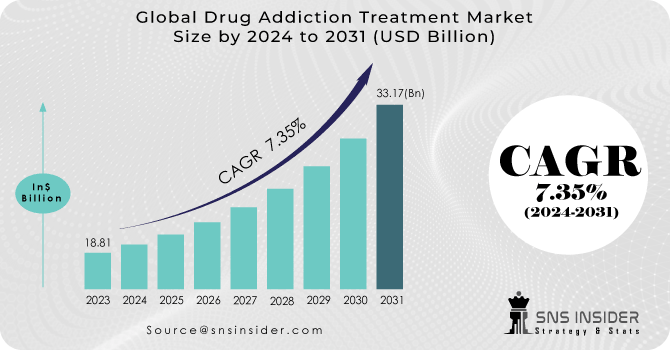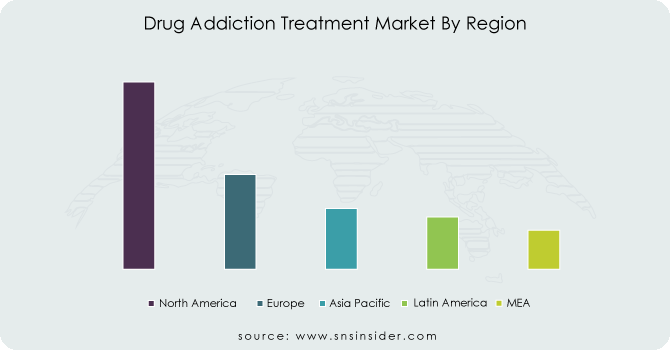Drug Addiction Treatment Market Report Scope & Overview:
The Drug Addiction Treatment Market size was estimated at USD 18.81 billion in 2023 and is expected to reach USD 33.17 billion by 2031 at a CAGR of 7.35% during the forecast period of 2024-2031.
On a global scale, drug overdose is one of the leading causes of death. According to the Centers for Disease Control and Prevention (CDC), over 91,000 people have died in the United States as a result of a drug overdose. According to data, drug overdose and regular intake of addictive substances have a negative impact on users' mental health, with the highest prevalence of Intermittent Explosive disorder (IED) and Attention-Deficit Hyperactivity Disorder (ADHD). Furthermore, the increasing number of campaigns and efforts launched by governments and other organizations to increase awareness about drug addiction, including the consequences of drug usage and dealing with drug-related issues, is boosting market revenue growth.

Get more information on Drug Addiction Treatment Market - Request Sample Report
Furthermore, official interventions offer a variety of distinct ideas on how to rehabilitate addicts, eliminate stigma associated with substance use, and starve the underground markets. Many countries have effectively updated their drug laws, enforcement strategies, and approaches to addiction. Another factor driving market revenue growth is the increasing use of Medication-Assisted Treatments (MATs) to treat opioid use disorders (OUDs). Several firms are pushing the use of pharmacological therapy in novel and more efficient ways to treat OUD. The US Food and Drug Administration (FDA) has issued draft recommendations supporting greater research and development of novel Medication-Assisted Treatment (MAT) drugs for opioid use disorder, which has recently become a severe healthcare epidemic in the United States.
According to the Centers for Disease Control and Prevention (CDC), approximately 114 people die each day from drug overdoses, and 6,748 people seek treatment in the Emergency Department (ED) for drug abuse or misuse in the United States. Furthermore, pharmaceuticals are responsible for approximately nine out of every 10 poisoning deaths. Prescription drug misuse and non-medical use are serious public health hazards all over the world, therefore prescription opioid painkillers are killing more people every year.
MARKET DYNAMICS
DRIVERS
-
The rising prevalence of drug-addicted individuals is a primary element driving market revenue growth.
The rising prevalence of patients with drug addiction and the rising number of deaths connected to Substance-Use Disorders (SUDs) are important factors driving individuals' demand for help and treatment, driving revenue growth in the global drug addiction treatment market. Through statistical knowledge of drug and alcohol abuse, tremendous progress has been made in the prevention and treatment of substance abuse over the last three decades. Furthermore, drug overdose deaths have been rapidly increasing and are now among the leading causes of death worldwide, owing to users' growing reliance on prescription medicines and a decrease in the perceived toxicity of specific drug classes.
RESTRAIN
-
Reluctance among drug-use disorder patients is a primary factor limiting market revenue growth.
OPPORTUNITY
-
Increased Government Initiatives and Funding for Addiction Treatment Laboratories
The recent addiction problem has increased the need to invest in integrated R&D initiatives focused on addiction treatment and rehabilitation. Despite the fact that the number of research efforts connected to addiction difficulties has expanded at an astonishing rate, players operating in the current addiction treatment market landscape are progressively finding innovative strategies to incorporate these results into real-world care delivery.
CHALLENGES
-
Reluctance Among Drug-Use Disorder Patients.
IMPACT OF RUSSIAN UKRAINE WAR
According to the study of reports and a news the russia ukraine war badly impected in ukraine, nongovernmental organizations (NGOs) primarily provided interventions in Ukraine to prevent bad health outcomes among those who inject drugs. In May 2021, approximately 15,700 drug users were receiving opioid agonist treatment, with women accounting for 16% of the total. By February 2022, that figure had risen to 17,210 people. The majority of those undergoing opioid agonist treatment in 2021 were men, who were less likely to have fled the nation since the conflict began. This was thought to be the number of people receiving such services throughout Eastern Europe and Central Asia. Ukraine was also the only country in Eastern Europe where opioid users could obtain naloxone without a prescription for overdose prevention and management.
GSMSG first assembled a 10-person combat surgery team, which reached Ukraine nine days after Russia invaded. Their mission was to train any interested and capable Ukrainian citizen in combat casualty care, to provide combat trauma care training and surgical support to the civilian Ukrainian medical system, and to provide combat care training to Ukrainian military personnel and military physicians. GSMSG rotated additional teams of surgeons with experience in trauma, surgical critical care, burn, plastics, orthopaedics, vascular, and neurosurgery. GSMSG rotated additional teams of surgeons with experience in trauma, surgical critical care, burn, plastics, orthopaedics, vascular, and neurosurgery. GSMSG also created a collaboration with the Ukrainian Armed Forces, Ukrainian Special Operations Forces (UKRSOF), and Ukrainian Special Surgical Groups, with the support of the Ukrainian Ministry of Defense and Ministry of Health, to offer damage control surgery as close to the scene as possible. as 0.5 kilometers from active action with Russian forces. Since their arrival in Ukraine, GSMSG team members have trained over 20,000 Ukrainian civilians and military personnel. They have also provided surgical support to over 300 patients, some of whom are within 10 kilometers of the battle lines.
IMPACT OF ONGOING RECESSION
Healthcare Spending Cuts During a recession, governments and individuals may face financial constraints, resulting in reduced healthcare budgets. Funding for drug addiction treatment programs and services may be jeopardized, perhaps leading to a reduction in treatment options. Services are in high demand. Economic downturns can cause stress, worry, and mental health problems, thereby boosting the demand for drug addiction treatment services as people struggle with financial difficulties. During a recession, healthcare organizations may need to prioritize important services and critical medical needs. This could have an impact on how money and attention are allocated to drug addiction treatment programs.Impact on Public and Nonprofit Programs During a recession, government funding for public drug addiction treatment programs may be curtailed, reducing the availability of inexpensive treatment options. Nonprofit organizations and charity foundations may confront similar difficulties in generating cash for their projects.
KEY MARKET SEGMENTATION:
By Treatment
-
Therapy
-
Medication
-
Others
By Types
-
Opioid Addiction
-
Benzodiazepine Addiction
-
Barbiturate Addiction
-
Others
By Route of Administration
-
Oral
-
Parenteral
-
Others
By Distribution Channel
-
Hospital Pharmacy
-
Retail Pharmacy
-
Others
By End-Users
-
Hospitals
-
Specialty Clinics
-
Others
REGIONAL COVERAGE
North America
-
US
-
Canada
-
Mexico
Europe
-
Eastern Europe
-
Poland
-
Romania
-
Hungary
-
Turkey
-
Rest of Eastern Europe
-
-
Western Europe
-
Germany
-
France
-
UK
-
Italy
-
Spain
-
Netherlands
-
Switzerland
-
Austria
-
Rest of Western Europe
-
Asia Pacific
-
China
-
India
-
Japan
-
South Korea
-
Vietnam
-
Singapore
-
Australia
-
Rest of Asia Pacific
Middle East & Africa
-
Middle East
-
UAE
-
Egypt
-
Saudi Arabia
-
Qatar
-
Rest of Middle East
-
-
Africa
-
Nigeria
-
South Africa
-
Rest of Africa
-
Latin America
-
Brazil
-
Argentina
-
Colombia
-
Rest of Latin America
REGIONAL ANALYSES
North America has suffered substantial opioid addiction concerns, particularly in the United States and Canada. Methadone and buprenorphine, two opioid replacement treatments, are commonly utilized. The region has a well-developed healthcare system that includes both public and private treatment facilities. Harm reduction measures and access to naloxone for overdose reversal have received increased attention. Opioid addiction is a problem in some parts of Europe, but there is also a wide spectrum of other substance abuse disorders. Treatment techniques vary by country, including medication-assisted treatment and psychological therapies. In several European countries, harm reduction techniques such as needle exchange programs and supervised injection facilities are widespread. The Asia-Pacific region is confronted with issues connected to opioid addiction, amphetamine use, and other narcotics. Access to treatment varies greatly among countries due to disparities in healthcare facilities and resources. Treatment-seeking behavior and methods of addiction treatment can be influenced by cultural and social factors.

Need any customization research on Drug Addiction Treatment Market - Enquiry Now
Key Players
The major key players are Takeda Pharmaceutical Company Limited, F. Hoffmann-La Roche Ltd, Abbott, Medtronic, Abbott, BD, Johnson & Johnson Services, Inc., GSK Plc., Bayer AG, Zimmer Biomet and Other Players.
Medtronic-Company Financial Analysis

RECENT DEVELOPMENTS
Pfizer, Inc: In 2022, announced a new strategic relationship with Alex Therapeutics to personalize treatment using digital therapeutics and use the latter company's Al-based platform to provide Cognitive Behavioral Therapy (CBT) and Acceptance and Commitment Therapy (ACT) to nicotine addiction patients.
| Report Attributes | Details |
| Market Size in 2023 | US$ 18.81 Bn |
| Market Size by 2031 | US$ 33.17 Bn |
| CAGR | CAGR of 7.35% From 2024 to 2031 |
| Base Year | 2023 |
| Forecast Period | 2024-2031 |
| Historical Data | 2020-2022 |
| Report Scope & Coverage | Market Size, Segments Analysis, Competitive Landscape, Regional Analysis, DROC & SWOT Analysis, Forecast Outlook |
| Key Segments | • By Treatment (Therapy, Medication, Others) • By Types (Opioid Addiction, Benzodiazepine Addiction, Barbiturate Addiction, Others) • By Route of Administration (Oral, Parenteral, Others) • By Distribution Channel (Hospital Pharmacy, Retail Pharmacy, Online Pharmacies, Others) • By End-Users (Hospitals, Specialty Clinics, Others) |
| Regional Analysis/Coverage | North America (US, Canada, Mexico), Europe (Eastern Europe [Poland, Romania, Hungary, Turkey, Rest of Eastern Europe] Western Europe] Germany, France, UK, Italy, Spain, Netherlands, Switzerland, Austria, Rest of Western Europe]). Asia Pacific (China, India, Japan, South Korea, Vietnam, Singapore, Australia, Rest of Asia Pacific), Middle East & Africa (Middle East [UAE, Egypt, Saudi Arabia, Qatar, Rest of Middle East], Africa [Nigeria, South Africa, Rest of Africa], Latin America (Brazil, Argentina, Colombia Rest of Latin America) |
| Company Profiles | Takeda Pharmaceutical Company Limited, F. Hoffmann-La Roche Ltd, Abbott, Medtronic, Abbott, BD, Johnson & Johnson Services, Inc., GSK Plc., Bayer AG, Zimmer Biomet |
| Key Drivers | • The rising prevalence of drug-addicted individuals is a primary element driving market revenue growth. |
| Market Restraints | • Reluctance among drug-use disorder patients is a primary factor limiting market revenue growth. |

